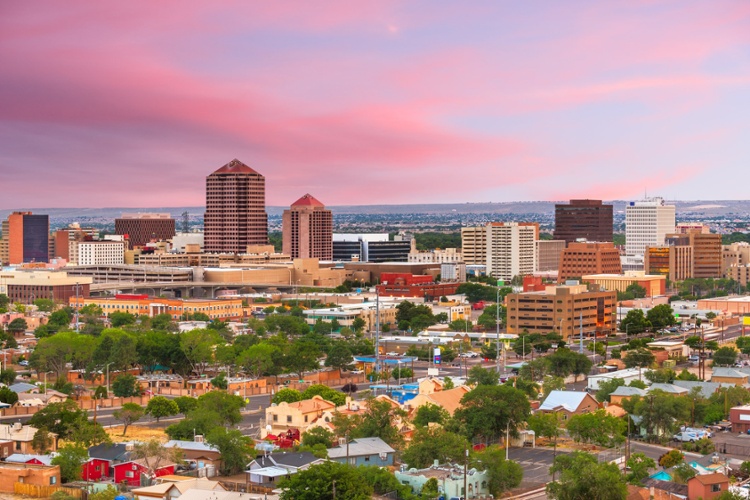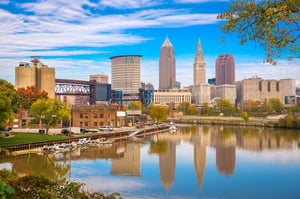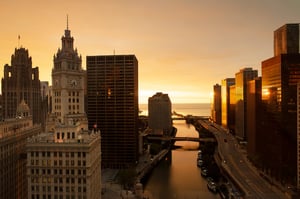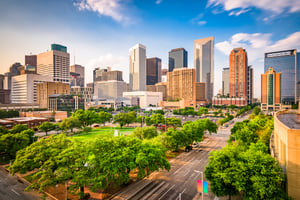Affordable real estate prices, a low cost of living and doing business, and a great quality of life are making Albuquerque a key destination for money makers and rental property investors.
According to a report from U.S. News & World Report, the real estate market in Albuquerque is still seeing multiple offers on homes, and still seeing people paying over list price, with newly-listed single-family homes going under contract in just 16 days.
Albuquerque is the most populated city in New Mexico and the state’s economic and business hub. Founded back in 1706 as a trading post, Albuquerque continues to be known for its many well-known trade routes including Route 66 and the Santa Fe Railway. The healthcare industry of New Mexico is centered in Albuquerque, and the metro area has also become a high-tech manufacturing hub.
While extreme weather and natural disasters can create havoc for businesses and residents in other parts of the country, Albuquerque is known as a low-risk location with a highly-skilled workforce, low cost of living, and aggressive business incentives that help keep the economy growing.
Here’s why nearly one million residents are finding Albuquerque the ideal place to live, work, and thrive.
Population growth
Since 1950, metropolitan Albuquerque has grown at a faster rate than the entire state of New Mexico. Historically, the area has seen a steady population increase of between 1% - 2% per year.
Key Population Stats:
- Albuquerque is the largest city in New Mexico with a population of over 564,000 in the city and over 916,000 people in the metropolitan area.
- Metro area of Albuquerque consists of Bernalillo, Sandoval, Torrance, and Valencia counties.
- Population of Albuquerque has declined by 0.3% year-over-year but has grown by more than 3.4% over the last 10 years, according to the most recent census.
- Unemployment in Albuquerque is currently 4.0% (April 2022) while employment growth last year was over 3.2%.
Job Market
Prior to the pandemic, job growth in Albuquerque reached a ten year high, according to the City of Albuquerque (ABQ). As business growth returns and the economy begins to rebound, employment sectors in Albuquerque showing the fastest growth include construction, manufacturing, leisure and hospitality, trade and transportation, and professional and business services.
Key Employment Stats:
- GDP of the Albuquerque MSA is over $45 billion, according to the Federal Reserve Bank of St. Louis, and has grown by nearly 22% in the last ten years.
- Employment growth in Albuquerque was 3.2% while median household incomes grew by 8.7%.
- Median household income in Metro Albuquerque is $55,370 while per capita income is over $30,397.
- Forbes ranked Albuquerque 126th in the nation as the best place for business and careers.
- Key industries in the Albuquerque metropolitan region are aerospace and aviation, solar technology and renewable energy, microsystems and nanotechnology, semiconductors and electronics, and IT software and cybersecurity.
- Major employers in Albuquerque include Kirtland Air Force Base, University of New Mexico, Sandia National Labs, Blue Cross Blue Shield of NM, Safelite Autoglass, and General Mills.
- Albuquerque is also home to high-tech companies such as Intel, Facebook, and Netflix.
- Major colleges and universities in Metro Albuquerque include the University of New Mexico, Central New Mexico Community College, Southwest University of Visual Arts, and Southwestern Indian Polytechnic Institute.
- Over 89.6% of the residents in Albuquerque are high school graduates or higher, while nearly 33.0% hold a bachelor’s degree or a postgraduate degree.
- Albuquerque is a regional hub for national and international distribution, offering reliable air, ground, and railroad service.
- Albuquerque International Sunport is served by eight major airlines and four regional airlines offering nonstop service to over 20 major cities including Chicago, New York, Dallas, and Atlanta.
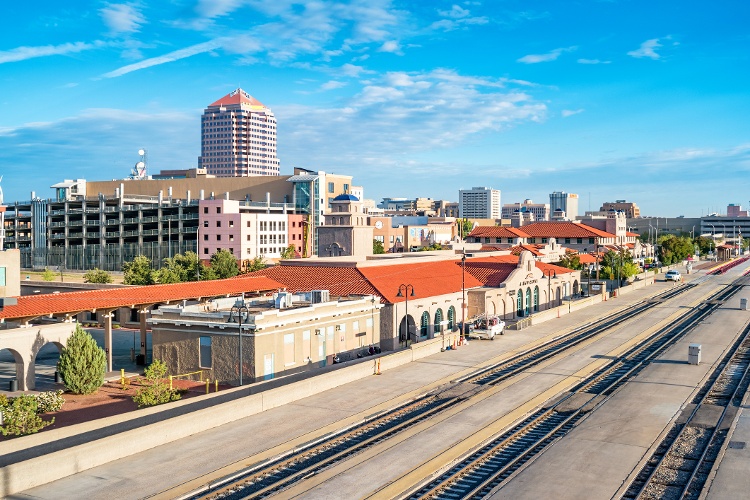
Real estate market
Home prices in Albuquerque and the surrounding suburbs are on the rise. According to station KRQE, [new link] home prices in nearby Rio Rancho and La Jara have increased by between 25% and 48% year over year.
Low interest rates combined with a shortage of homes for sale are packing out some open houses with people interested in buying. The number of good, high-paying jobs in the Albuquerque metro area has also turned the city into a destination for money-makers.
Key Market Stats:
- Zillow Home Value Index (ZHVI) for Albuquerque is $277,530 as of November 2021.
- Home values in Albuquerque have increased by 19.0% over the last year.
- Over the past five years home values in Albuquerque have increased by more than 62%.
- Median sale price of a single-family home in Albuquerque is $340,500 according to the most recent report from the Greater Albuquerque Association of Realtors (GAAR) as of May 2022.
- Sales prices of single-family homes in Albuquerque have increased by 17.4% year-over-year.
- Days on market from listing to contract is 13 on average.
- Inventory of single-family homes for sale in Albuquerque has decreased by 16.8% year-over-year.
- Of the 207 neighborhoods in Albuquerque, High Desert is the most expensive with a median listing price of $612,000, according to Realtor.com.
- Most affordable neighborhood in Albuquerque is Near North Valley with a median home listing price of $190,000.
Attractive renters’ market
Albuquerque, New Mexico is listed by WalletHub as one of the best market for renters, with strong markets for rental market & affordability, and a great quality of life.
Metro Albuquerque is also listed as one of the best places to buy rental property for cash flow and appreciation. The area’s steady population and job growth, along with affordable real estate prices, offer pretty much everything a remote real estate investor could ask for.
Key Market Stats:
- Median rent in Albuquerque is $1,800 per month for a 3-bedroom home, based on the most recent research from Zumper (June 2022).
- Rents in Albuquerque have increased by 13% year-over-year.
- Over the past 3 years, rents in Albuquerque for a 3-bedroom place have increased by nearly 38%.
- Renter-occupied households make up 41% of the total occupied housing units in Albuquerque.
- Neighborhoods in Albuquerque with the most affordable rents include La Mesa, Trumbull Village, and Los Volcanes where rents run between $800 and $870 per month.
- Most expensive neighborhoods to rent in Albuquerque include Downtown Albuquerque, Heritage East, and Nor Este where rents can range from $2,323 to $3,500 per month.
Historic price changes & housing affordability
There are a number of ways that real estate investors can analyze different markets across the U.S. to determine the potential demand for rental property. Among these various tools are monitoring the historical change in local housing prices and the affordability of housing in each market.
Freddie Mac publishes a monthly house price index (FMHPI) that measures the change in home prices for real estate markets in the U.S. The report assigns December 2000 with a benchmark of 100 and then compares the monthly change in housing prices in each state and metro area to 100.
The most recent FMHPI from Freddie Mac for the Albuquerque housing market shows:
- April 2017 HPI: 150.2
- April 2022 HPI: 235.8
- 5-year change in home prices: 56.9%
- One-year change in home prices: 17.1%
- Monthly change in home prices: 1.4%
Another metric that real estate investors can use to help decide how good a market is for rental property is housing affordability.
The annual report published by Kiplinger’s Personal Finance measures home prices in the top 100 metropolitan areas, then assigns each real estate market an affordability scale from 1 to 10, with 1 being the most affordable places to own and 10 the most expensive markets to own a house in.
The affordability index report from Kiplinger for Albuquerque shows:
- Since the last real estate cycle market peak in May 2006, home prices in Albuquerque have increased by 11.5%.
- Since the last real estate cycle market bottom in March 2012, home prices in Albuquerque have increased by 55.3%.
- Albuquerque has an affordability index of 6 out of 10, meaning that Albuquerque is one of the least affordable markets to buy a home.
Quality of life
Albuquerque is one of the best places to build wealth thanks to the metro area’s low cost of living and quality of life, according to Albuquerque Economic Development. In fact, the Albuquerque metropolitan area ranks below the national index for key cost of living measurements including groceries, utilities, transportation, and health care.
Key Quality of Life Stats:
- Cost of living in Albuquerque is 4% below the national average, according to Forbes.
- Albuquerque is a more affordable place to live than other major western and southwestern markets such as Dallas, Denver, Las Vegas, and Phoenix.
- Niche.com gives Albuquerque an B+ grade for quality of life, with high rankings for weather, public schools, and outdoor activities.
- Albuquerque is rated as one of the best places to live in the country by U.S. News & World Report, with strong ratings for value, job market, and overall desirability.
- Albuquerque is ranked as the 13th best commute city in the nation, with an average commute time of just 24 minutes.
- With 310 days of sunshine a year, Albuquerque residents enjoy a temperate semi-arid climate.
- Metro Albuquerque is home to a wide range of housing styles and price ranges, from urban lofts in Downtown Albuquerque to the booming suburban areas of Rio Rancho and Los Lunas.
- The Albuquerque – Santa Fe region offers world-class opera, small theatre performances, tribal historical museums, and nearly 300 art galleries in the greater metropolitan area.
- Albuquerque’s International Balloon Fiesta attracts more than 800,000 visitors from around the world each year and is one of the most photographed events in the world.
- The University of New Mexico is a nationally recognized Class I medical research institution, while the Lovelace Respiratory Research Institute is recognized around the world for its biomedical research.
Get out the map
Where to begin your search? Roofstock created a heat map of Albuquerque based on our Neighborhood Rating, a dynamic algorithm that enables you to make informed investment decisions by measuring school district quality, home values, employment rates, income levels, and other vital investment criteria.
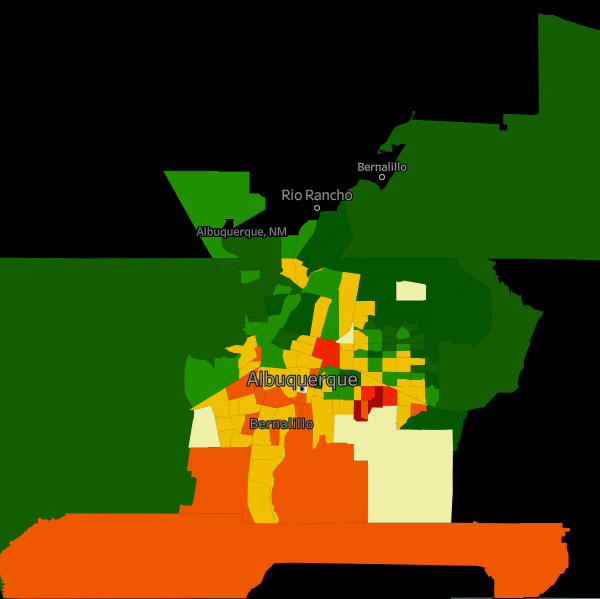
DARK GREEN: 4-5 star neighborhood
LIGHT GREEN: 3.5-4 star neighborhood
YELLOW: 2.5-3 star neighborhood
ORANGE: 2 star neighborhood
RED: 1 star neighborhood
Ready to invest in the Albuquerque housing market? If you haven't already done so, create your free Roofstock account and set up alerts. We'll notify you when we have an Albuquerque, New Mexico investment property that matches your search criteria.


